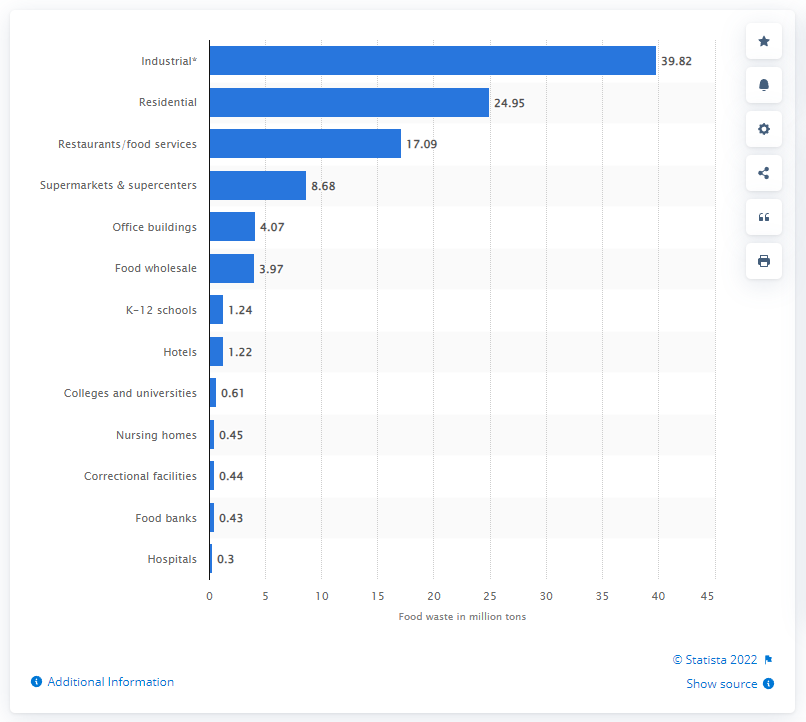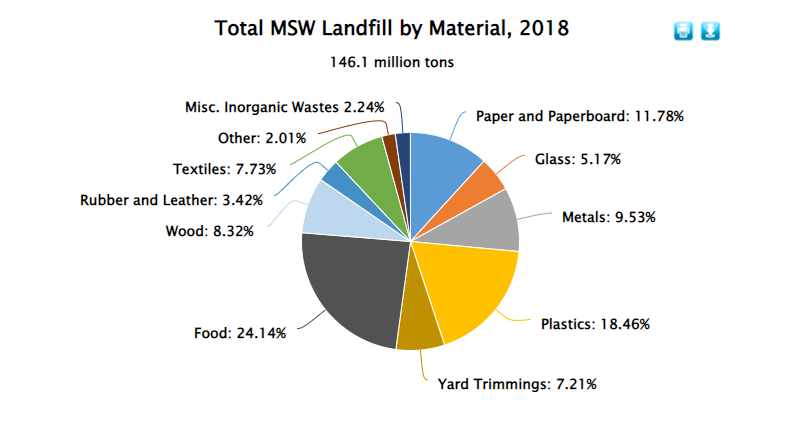13+ Food Waste Statistics That Need Your Urgent Attention

Food waste statistics like these can be a shock to the system. Today we take a pragmatic look at the state of food scraps and waste in North America – with a view to make things better.
According to the EPA, municipal food waste is generated by the residential, commercial, and institutional sectors. Some 55% of scraps are landfilled, while only 12% are combusted.
Let’s investigate what else is happening to wasted food in the US and spot opportunities for improvement in your city along the way.
Here are 13 food waste statistics and facts to inspire change in your municipality.
#1: 103 million tons of food waste is created in the US every year
To give you context on how large that is, it’s the equivalent of about 116 Golden Gate Bridges stacked side by side in one enormous stack.

#2: Half of all food in the US is discarded making it the world-leader in organic waste
With some 50% of the food grown, about a third of all food is thrown away because it’s ugly. According to a report from The Guardian, Americans won’t buy imperfect looking food, which means that about $160 billion in food is wasted each year because it’s not picture-perfect enough.
Does your municipality have an ugly-food program?
#3: 39.82% of discarded food in the US is from the industrial sector
The industrial sector includes agriculture and food processing so it’s no wonder this segment tends to create the most waste, it’s where most of the food is grown.
#4: 24.95% of food scraps and waste in the US comes from residential sectors
Unsurprisingly, the second largest portion of waste comes from residential areas. Municipalities should take action to promote green waste composting and greater educational programs for the community to encourage proper food utilization, waste reduction and correct disposal.

#5: 33.81% of food-related waste in the US comes from commercial sectors
Commercial sectors include restaurants and food service companies, supermarkets and centers, office buildings and food wholesalers.
#6: 4.69% of food waste in the US comes from institutional sectors
Leading the pack are K-12 schools with 1.24%, hotels with 1.22% and colleges and universities with 0.61%. Other institutions like nursing homes, correctional facilities, hospitals, and food banks are also included in this sector.
#7: 6.3% of food waste was diverted from landfills to become compost
Your municipal community may be composting, but more people need to be doing it to lower the landfill burden in your area. Only a tiny percentage is diverted, which is why most of the waste in any given landfill site is food.
#8: 24.14% of all landfilled material is food-related waste
According to the EPA, of the 146.1 million tons of material found in US landfills, the overwhelming majority is food waste. It’s greater than plastic (18.46%) and paper (11.78%).
#9: 100% of food scraps at a landfill take years to decompose
Most people believe that because food waste is organic, it will decompose at the landfill. The problem of course, is that landfills were created for storage and not composting. With so many mixed varieties of trash, food scraps rot, releasing harmful greenhouses gasses for years.
Educate your community about food waste and what happens when it’s thrown in the trash.

#10: 85% of greenhouse gasses that are ruining our planet come from discarded food items
When your municipality commits to programs that help community members compost, reduce food waste, and recycle better – you are actively helping to lower gas emissions at your local landfill.
#11: 40% of US customers throw food away too early
There is widespread confusion about the meaning of food expiration dates printed on consumer items these days. This has led to people throwing away food that is still safe to eat, contributing to the massive food waste issue in the country.
#12: Money is a primary motivator to get consumers to reduce their food waste
In a recent study, respondents were found to be more concerned about saving money than saving the environment. Clearly money and the successful utilization of food are tied together. Consider this when developing food waste programs for your municipality.
#13: 30% of global livestock feed comes from food-related waste
One way to divert food waste from landfills is to use it as animal feed. Right now, there’s enormous demand for animal feed and plenty of room for program growth.
It’s clear that without intervention waste will continue to be created and will end up in our landfills. Take a moment to consider how you could help reduce or solve the food waste crisis.
Use these 13 food waste statistics to inform your next recycling or composting program. Sit down with your recycling co-ordination team and come up with a plan to educate your community, and reduce the overall impact of food waste in your municipality.
Which food waste statistic surprised you? Tell us below.